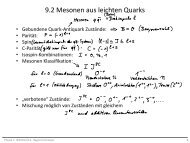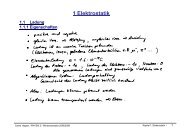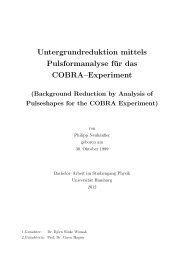Setup of a Drift Tube Muon Tracker and Calibration of Muon ...
Setup of a Drift Tube Muon Tracker and Calibration of Muon ...
Setup of a Drift Tube Muon Tracker and Calibration of Muon ...
You also want an ePaper? Increase the reach of your titles
YUMPU automatically turns print PDFs into web optimized ePapers that Google loves.
muons, is reduced by going deep underground. However, a complete shielding againstbackground is not possible <strong>and</strong> it has thus to be studied thoroughly. This sectiongives a brief overview <strong>of</strong> background sources in Borexino <strong>and</strong> describes how they canbe discriminated. Special care is given to the uncorrelated cosmogenic backgroundinduced by muons.4.3.1 RadioactivityNatural radioactive elements are intrinsic to both the scintillator <strong>and</strong> the surroundingmaterials. The most prominent background source in Borexino is the naturalabundance <strong>of</strong> 14 C in organic materials <strong>and</strong> hence in the scintillator. At the Earth’ssurface, a 14 C has a relative abundance to 12 C <strong>of</strong> approximately 1.2 × 10 −12 g/g.However, this concentration is already significantly reduced due to the fact that thescintillator is based on a mineral oil that has been formed underneath the Earth’ssurface during a long time compared to the 14 C half-life <strong>of</strong> 5730 years. In Borexinoa 14 C cleanliness <strong>of</strong> the order <strong>of</strong> 10 −18 compared to 12 C has been reached, resultingin a rate <strong>of</strong> 3.5×10 4 counts per day <strong>and</strong> ton. While decays <strong>of</strong> 14 C limit the detection<strong>of</strong> neutrinos to energies above the 14 C end point energy <strong>of</strong> ∼156 keV, their numberis reduced sufficiently to not constantly blind the detector.Further intrinsic radioactivity arises mainly from the decay chains <strong>of</strong> 238 U <strong>and</strong>232 Th, as well as 40 K. Special care also has to given to the presence <strong>of</strong> 222 Rn. It is anoble gas formed in the 238 U decay chain. In Hall C <strong>of</strong> the LNGS laboratory, radonactivities around 80Bq/m 3 are measured. It is hence utterly important to preventany contact between the air <strong>and</strong> the scintillator. The same is true to prevent acontamination <strong>of</strong> the scintillator with 85 Kr, which has a Q value <strong>of</strong> 690 keV, a valueclose to the expected Compton edge from the 7 Be neutrinos. Its content in thescintillator can be probed through the rare decay sequence 85 Kr → 85 Rb ∗ + e + + ν ewith the delayed coincidence <strong>of</strong> 85 Rb ∗ → 85 Rb + γ. The activity <strong>of</strong> 85 Kr has thusbeen estimated to be 29 ± 14 counts per day <strong>and</strong> 100 tons.4.3.2 NeutronsNeutrons knocked out <strong>of</strong> the surrounding materials by cosmic muons are a seriousthreat to the Borexino measurements. Neutrons created by muons passing next tothe detector are particularly critical, because their parent cannot be identified <strong>and</strong>vetoed. High energy neutrons may travel a distance <strong>of</strong> a few meters through differentmaterials. Through elastic scattering, the neutron loses its energy to protons <strong>and</strong>thus leaves a signal in the detector. If it is thermalized within the scintillator, adelayed 2.2 MeV γ will be released from the neutron capture on Hydrogen. Thissignature can mimic the signal from the inverse β decay.4.3.3 Cosmogenic BackgroundThe Borexino experiment is well shielded from cosmic radiation by ∼ 3800 m.w.e.<strong>of</strong> rock. The cosmic muon flux in Hall C <strong>of</strong> the LNGS is reduced by almost 6orders <strong>of</strong> magnitude to ∼ 1.2µ/m 2 /h compared to the flux on the Earth’s surface(∼ 6.5 ×10 5 µ/m 2 /h). However, this still corresponds to approximately 4300 muonscrossing the detector each day. The mean energy <strong>of</strong> these muons is about 320 GeV,58





